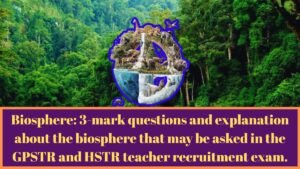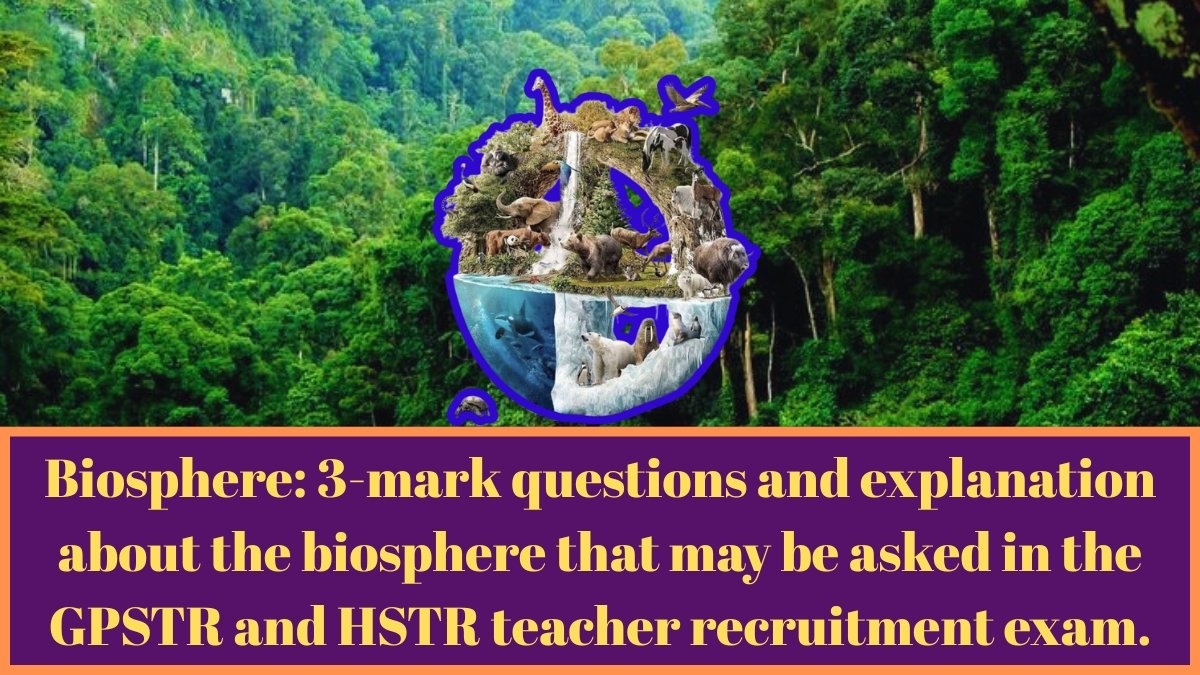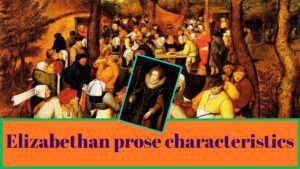Biosphere: 3-mark questions and explanation about the biosphere that may be asked in the GPSTR and HSTR teacher recruitment exam.

1.Trees are leafless for a shorter or longer season of the year in:
1) Evergreen forest
2) Mangrove forest
3) Scrub jungle forest
4) Deciduous forest
Ans:- 4) Deciduous forest
• Deciduous forests: The distribution of these forests is based on the distribution of rainfall.
• The trees in these forests shed their leaves seasonally.
• Trees shed their leaves regularly over a 6-8 week period during the spring and early summer.
• During this period, the water supply to the roots of trees is very low, so trees have adapted to shed their leaves to limit the moisture released into the atmosphere through their leaves.
• New leaves appear with the onset of the monsoon rains.
—————————————————————————
2. Snakes and vultures are eating rats in a field. If wild dogs are let into the field, what will be the immediate result?
1) Decrease in the number of snakes
2) Decrease in the number of vultures
3) Decrease in the number of rats
4) Increase in the number of snakes.
Ans:- 3) Decrease in the number of rats
• Since rats are prey to all three (snake, vulture, wild dog), there is a decrease in the number of rats, and this leads to the conclusion that there is a decrease in the number of rats.
—————————————————————————
3. The sphere of living matter together with water, air and soil on the surface of the earth is known as
1) Lithosphere
2) Biosphere
3) Hydrosphere
4) Atmosphere
Ans:- 2) Biosphere
• Biosphere:- The lithosphere, atmosphere, and atmosphere of the Earth where living things exist.
• and the divisions of the hydrosphere are the biosphere or biosphere. The biosphere extends from sea level to about 10,000 m. high in the atmosphere and to 9,000 m. deep in the oceans. All living things on Earth are found in this zone. The biosphere includes both biotic and abiotic factors.
———————————————————————–
4. The largest ecosystem of the Earth is
1) Biome
2) Hydrosphere
3) Lithosphere
4) Biosphere
Ans:- 1) Biome
• A large area of land with similar natural features, containing a complementary biological diversity of plants, animals and organisms.
• The total amount of living matter in such areas is called a biome. A biome is a biogeographic unit that contains a community of living things. It is also called a major biome. A large area of land is a region that contains a diverse community of plants and animals. It is the largest geographical biogeographic unit that contains a variety of communities of major features of an area, such as grasslands, deserts, or forests.
————————————————————————-
5. An artificial ecosystem is represented by:
1) Fish farming tank
2) agricultural land
3) Zoo
4) aquarium
Ans:- 4) aquarium
• Artificial ecosystems are those created by humans. Natural ecosystems are biological environments that occur freely in nature. Example: desert, forest, wetlands, rivers etc.
• Artificial Ecosystems:- Ecosystems created by humans are called artificial ecosystems. Examples: aquariums, crop fields, dams, gardens, ponds, etc.
————————————————————————-
6. Which is the most stable ecosystem?
1) Desert
2) Ocean
3) Mountain
4) Forest
Ans:- 2) Ocean
• An ecosystem may be natural or man-made, large or small, permanent or temporary, complete or incomplete.
• Natural ecosystem:- This is an ecosystem that has developed under natural conditions without any human intervention. Oceans form the most stable ecosystem.
• Temporary ecosystem:- This is a short-lived and man-made ecosystem. Examples include a rain-fed pond.
• Permanent ecosystem:- It is a natural ecosystem that is self-sustaining over a long period of time and for a long period of time. Examples include forests, rivers, seas, mountain ranges, etc.
————————————————————————–
7. An ecosystem consists of:
1) producers, consumers and decomposers in a particular area
2) all the plants and animals of an area
3) a living community and its environment
4) carnivorous and herbivorous of an area
Ans:- 3) a living community and its environment
• As Tanest explains: All the species that have lived in a particular geographical area.
• An ‘Ecosystem’ is a system of living organisms, their physical environment, and the functional units that they interact with. ‘Eco’ means environment and ‘system’ means system.
————————————————————————
Biosphere: 3-mark questions and explanation about the biosphere that may be asked in the GPSTR and HSTR teacher recruitment exam.

8. The area reserved for the welfare of wild life is called:
1) Sanctuary
2) Forest
3) National Park
4) Botanical garden
Ans:- 3) National Park
• National Park:
• National parks are established to protect the original natural habitats of wildlife species such as tigers, lions, rhinos, and elephants.
• These range in size from 0.04 sq km to 3162 sq km.
• There are 106 national parks in India (as of 2022).
• They cover an area of 44,372.42 km², which is 1.35% of the country’s geographical area (National Wildlife Data, May 2022).
————————————————————————-
9. There is a need to keep larger area under forests for:
1) absorption of carbon dioxide
2) protecting wildlife
3) raising precipitation
4) geological balance
Ans:- 1) absorption of carbon dioxide
• Plants use carbon dioxide & other nutrients from the atmosphere to make food through photosynthesis. That is why forests are considered carbon dioxide sinks.
• A carbon sink is the absorption of carbon from the atmosphere, but in recent times, due to human activities on Earth, forests are releasing more carbon than they absorb, leading to increased global warming and climate change.
———————————————————————-
10. Global warming is expected to result in
1) Increase in level of sea
2) Change in crop pattern.
3) Change in coastline
4) All of the above
Ans:- 4) All of the above
• Global warming is the phenomenon of a gradual increase in temperature on Earth.
• There are several causes of global warming, which can be natural or the result of human activities.
• Deforestation, excessive use of vehicles, ozone layer depletion due to CFCs released by air conditioners and refrigerators, various agricultural activities produce carbon dioxide and methane gas. These add to the greenhouse gases in the atmosphere and increase the temperature of the earth. Due to all these reasons, the melted snow water flows into the sea and the sea level rises. Also, there are changes in crop patterns, changes in coastlines, increase in temperature, climate change, spread of diseases, loss of natural habitats, etc.
————————————————————————–
11. Man can maintain an ecological balance in the biosphere by
1) deforestation
2) developing new breeds cultivated plants and domesticated animals
3) using insecticides and pesticides
4) understanding the delicate balance in the relative nurber of organisms
Ans:- 4) understanding the delicate balance in the relative nurber of organisms
• Ecological equilibrium is a state of dynamic balance within a community of organisms in which genetic, species & ecosystem diversity are relatively constant.
• Generally, it refers to a stable balance in the number of each organism in an ecosystem. To maintain this balance, one must understand the delicate balance between organisms and the ecosystem. For example, if there are only herbivorous animals in a grassland area, the grassland is likely to gradually disappear. If the number of herbivorous and carnivorous animals is maintained, the area can be stabilized.
———————————————————————–
12. Which of the following exhibits unidirectional flow in an ecosystem?
1) Light
2) Energy
3) Water
4) Biomass
Ans:- 2) Energy
• Unidirectional flow refers to the path that energy follows in an ecosystem.
• For example:- Plants use only 21% of the total energy from the sun for their growth. Then herbivorous animals eat the plants and get 17% of the energy produced by the plants. In this system, the remaining energy that is not used goes back to the earth and atmosphere. Each level of organism gets only 10% of the energy from the food they eat. In this above system, the flow of energy is one-way.
• Plants do not return the heat received from the sun. Similarly, food is not returned to plants by herbivores. Therefore, if any point in this one-way energy flow is interrupted, the energy flow will stop.
———————————————————————–
13. Rubber plantations are found in
1) Temperate forests
2) Mountain regions
3) Polar regions
4) Equatorial regions
Ans:- 4) Equatorial regions
• Thosko Dat:
• It belongs to the perennial evergreen plant family and is restricted to humid tropical climates. Due to this, this crop is usually found in the equatorial region.
• Temperature:- Average temperature is 250 to 35° Celsius.
• Rainfall:- Annual rainfall should be more than 200 cm.
• Soil:- Sandy clay is the most suitable soil for this.
• Terrain:- Rubber trees grow on steep hillsides up to 1000 meters in elevation.
————————————————————————
14. “Tidal forest” is otherwise called:
1) Evergreen forest
2) Monsoon forest
3) Mangrove forest
4) Coniferous forest
Ans:- 3) Mangrove forest
• Tidal forests are called mangrove forests.
• Mangrove or Littoral Forests Although mangrove forests also belong to the group of evergreen forests, they grow under unique conditions and have unique characteristics.
• Mangrove forests are found in coastal lowlands and low-lying estuaries.
• These forests prevent the tides that occur during the sea’s surge or high tide.
————————————————————————
15. Which of the following metals contribute to biomagnifications problem in the ecosystem?
1) Mercury
(2) Chromium
3) Copper
(4) Lead
Ans:- 1) Mercury
• Mercury causes a biomagnification problem in the ecosystem.
———————————————————————–





